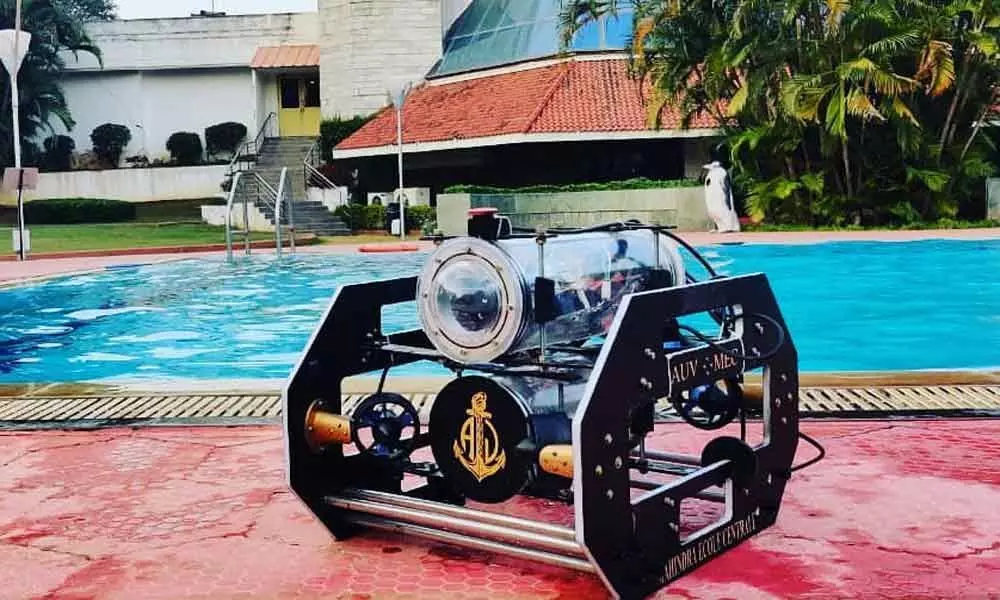Live
- Congress remembers Dalits only in bad times: Mayawati taunts Rahul Gandhi on Parbhani visit
- Have time for jailed leaders but none for achievers: BJP slams Delhi govt over chess champion’s pain
- Alliance University holds 13th Convocation, 1145 students receive degrees
- SC orders strict action against illegal construction
- Man kills sibling over property dispute
- Karnataka gets third govt cardiology hospital
- Minister Ramalinga’s efforts help safeguard over 10,000 acres of temple Land
- Laxminarayan College gets NAAC B+ accreditation
- Champions Trophy: India vs Pakistan Match Likely to Be Held on This Date
- Tigress Zeenat spotted in Purulia
Just In
First Autonomous Underwater Vehicle Black Pearl created


Mahindra Ecole Centrale (MEC) has announced the launch of its first Autonomous Underwater Vehicle (AUV) named Black Pearl. Created by MEC students and mentored by their professors, the Black Pearl is a self-propelled, unmanned, untethered underwater vehicle capable of carrying out simple activities with little or no human supervision. Simply put, it is a computer-controlled system (or a Robot) operating underwater.
Hyderabad: Mahindra Ecole Centrale (MEC) has announced the launch of its first Autonomous Underwater Vehicle (AUV) named Black Pearl. Created by MEC students and mentored by their professors, the Black Pearl is a self-propelled, unmanned, untethered underwater vehicle capable of carrying out simple activities with little or no human supervision. Simply put, it is a computer-controlled system (or a Robot) operating underwater.
Autonomous Underwater Vehicles operate independently of humans and are self-guiding and self-powered vehicles. AUVs have a wide range of applications in marine sciences, and are increasingly being tested and used by commercial, civil and defence sectors. The AUV project is one of the most complicated in-house projects to take shape at Mahindra Ecole Centrale, with its inherent innovative integration of computer science, mechanical, electrical and electronics engineering, the AUV is currently capable of carrying out navigational and other tasks pre-fed into its memory with good precision and near-zero error.
"Our students continue to exhibit strong interests in R&D and creativity in building workable prototype devices and gadgets for different segments. Black Pearl is another such product where the students and their academic and research mentors worked tirelessly at our Centre for Robotics and created a robust Autonomous Underwater Vehicle. We are very proud to be creating New Engineers who work on complex projects, sharpen their technical and project management skills becoming more competitive, innovative and future-ready, true to the "Rise" philosophy of the Mahindra Group", says Dr. Yajulu Medury, Director, Mahindra Ecole Centrale.
Prof. Arya Kumar Bhattacharya, Dean R&D, MEC, ensured knowledge sharing and mentoring on principles of system engineering went a long way in enabling the near flawless output within pre-set timelines. Faculty mentor, Dr. Sebastian Uppapalli of the Mechanical Engineering Department at Mahindra Ecole Centrale tirelessly mentored the students assigned to the project. The team primarily responsible for creating the AUV included Naval Pattar(Fabrication), Nishith(Design), Pulkit(Simulations), Suresh(Control and Embedded Systems), Srikanth Gadde(Control and Embedded Systems),Kartikeya(Vision Systems) while the overall project was led by Sai Madhavan (Team Lead), and Sai Kiran Kumar(Deputy Team Lead).
Weighing 19.6 Kgs, MEC's Black Pearl is a fully autonomous operation and carries power onboard through a Lithium Polymer Battery. Powered by NVidia Jetson Nano Single board computer and Arduino micro controller, MEC's Black Pearl is a free-swimming, untethered robot boasting of a Logical 270 vertical camera and Raspberry Pi V2 horizontal camera to take good quality images. Nearly Rs. 3,70,000 were spent in developing the vehicle in-house.
The MEC's Black Pearl is currently capable of executing instructions that have been hard coded into it, with high accuracy and with minimal error. Over the span of the next few months it would be made capable of taking inputs from the sensors (Depth, Echosounder, Camera, etc.), process them, and based on the data, navigate its trajectory so that it can avoid obstacles, retrieve objects from the water floor and carry out dedicated missions. Black Pearlis equipped with multiple thrusters, which give it five degrees of freedom-Roll, Yaw, Surge, Heave and Sway, and it would soon have a manipulator/robotic arm so that it can acquire objects.
The Jetson Nano and Camera would do the image processing tasks and employ Neural Networks to help in the task of trajectory planning and optimization.

© 2024 Hyderabad Media House Limited/The Hans India. All rights reserved. Powered by hocalwire.com






